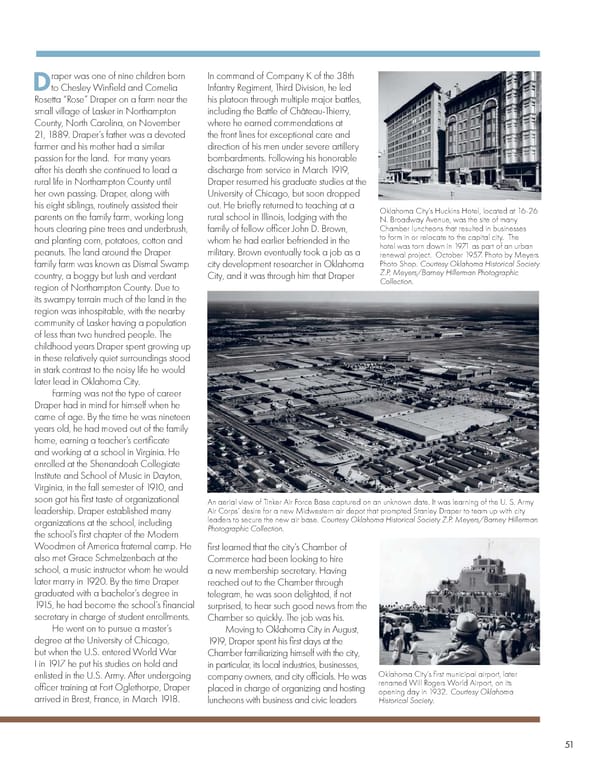raper was one of nine children born In command of Company K of the 38th Dto Chesley Winfield and Cornelia Infantry Regiment, Third Division, he led Rosetta “Rose” Draper on a farm near the his platoon through multiple major battles, small village of Lasker in Northampton including the Battle of Château-Thierry, County, North Carolina, on November where he earned commendations at 21, 1889. Draper’s father was a devoted the front lines for exceptional care and farmer and his mother had a similar direction of his men under severe artillery passion for the land. For many years bombardments. Following his honorable after his death she continued to lead a discharge from service in March 1919, rural life in Northampton County until Draper resumed his graduate studies at the her own passing. Draper, along with University of Chicago, but soon dropped his eight siblings, routinely assisted their out. He briefly returned to teaching at a Oklahoma City’s Huckins Hotel, located at 16-26 parents on the family farm, working long rural school in Illinois, lodging with the N. Broadway Avenue, was the site of many hours clearing pine trees and underbrush, family of fellow officer John D. Brown, Chamber luncheons that resulted in businesses and planting corn, potatoes, cotton and whom he had earlier befriended in the to form in or relocate to the capital city. The peanuts. The land around the Draper military. Brown eventually took a job as a hotel was torn down in 1971 as part of an urban renewal project. October 1957. Photo by Meyers family farm was known as Dismal Swamp city development researcher in Oklahoma Photo Shop. Courtesy Oklahoma Historical Society country, a boggy but lush and verdant City, and it was through him that Draper Z.P. Meyers/Barney Hillerman Photographic region of Northampton County. Due to Collection. its swampy terrain much of the land in the region was inhospitable, with the nearby community of Lasker having a population of less than two hundred people. The childhood years Draper spent growing up in these relatively quiet surroundings stood in stark contrast to the noisy life he would later lead in Oklahoma City. Farming was not the type of career Draper had in mind for himself when he came of age. By the time he was nineteen years old, he had moved out of the family home, earning a teacher’s certificate and working at a school in Virginia. He enrolled at the Shenandoah Collegiate Institute and School of Music in Dayton, Virginia, in the fall semester of 1910, and soon got his first taste of organizational An aerial view of Tinker Air Force Base captured on an unknown date. It was learning of the U. S. Army leadership. Draper established many Air Corps’ desire for a new Midwestern air depot that prompted Stanley Draper to team up with city organizations at the school, including leaders to secure the new air base. Courtesy Oklahoma Historical Society Z.P. Meyers/Barney Hillerman the school’s first chapter of the Modern Photographic Collection. Woodmen of America fraternal camp. He first learned that the city’s Chamber of also met Grace Schmelzenbach at the Commerce had been looking to hire school, a music instructor whom he would a new membership secretary. Having later marry in 1920. By the time Draper reached out to the Chamber through graduated with a bachelor’s degree in telegram, he was soon delighted, if not 1915, he had become the school’s financial surprised, to hear such good news from the secretary in charge of student enrollments. Chamber so quickly. The job was his. He went on to pursue a master’s Moving to Oklahoma City in August, degree at the University of Chicago, 1919, Draper spent his first days at the but when the U.S. entered World War Chamber familiarizing himself with the city, I in 1917 he put his studies on hold and in particular, its local industries, businesses, enlisted in the U.S. Army. After undergoing company owners, and city officials. He was Oklahoma City’s first municipal airport, later officer training at Fort Oglethorpe, Draper placed in charge of organizing and hosting renamed Will Rogers World Airport, on its arrived in Brest, France, in March 1918. opening day in 1932. Courtesy Oklahoma luncheons with business and civic leaders Historical Society. 51 35
 June 2021 Oklahoma Hall of Fame Magazine Page 52 Page 54
June 2021 Oklahoma Hall of Fame Magazine Page 52 Page 54